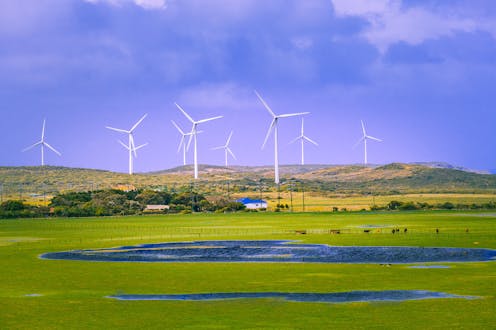Investors have bid against each other to buy Australia’s first green bond. Here’s why that’s a great sign
- Written by Gordon Noble, Research Director, Institute for Sustainable Futures, University of Technology Sydney

You might think government debt is bad, but it actually plays a crucial role in modern finance.
Back when he was treasurer, Peter Costello famously declared[1] that April 21 2006 would be known as Australia’s “Debt Free Day”. On this day, he proclaimed, the Commonwealth would eliminate its net debt and “pay off the mortgage”.
The problem – as financial markets were quick to point out – was that government bonds (used to issue debt) were critical for all lending decisions in the Australian economy. A government that didn’t borrow at all would create different problems.
As Costello himself later reflected[2]:
Government or sovereign bonds are the lifeblood of the financial system […] Although their primary purpose is to allow a government to borrow, trading in the bonds establishes the yield curve. It becomes the benchmark for other borrowers – state governments and institutions as well as the private sector.
The financial markets were unnerved at the prospect that there might be no Australian government securities on issue to underpin and price the debt market.
Instead of ceasing to issue bonds, the Australian government decided to use its surpluses to establish the Future Fund.
Leveraging debt for green goals
Almost 20 years later, Australian financial markets have reached a new milestone. Government debt is now being issued to drive bold action on the environment.
This month, the federal government issued Australia’s first sovereign green bond[3] to back projects supporting the net-zero transition.
The A$7 billion bond issue was heavily over‑subscribed. More than $22 billion in bids came from 105 investor institutions across Australia, Asia, Europe and North America.
But it isn’t a new idea. The first green bond[5] was issued by the World Bank in 2008, following interest from Swedish pension funds who wanted to support investments tackling climate change but had struggled to find projects.
This then led to a flurry of activity, including the 2009 founding of the Climate Bonds Initiative by Sean Kidney, an Australian expat who has been a driving force behind green bond markets globally.
As green bonds gained traction, the International Capital Markets Association established the Green Bond Principles[6] to “support issuers in financing environmentally sound and sustainable projects that foster a net-zero emissions economy and protect the environment”.
In 2023, about A$1.4 trillion of impact bonds were issued[7] globally, including green, social, sustainability and sustainability-linked bonds.
A watershed moment
Sustainable finance is now at a critical juncture. The World Bank says[8] financial markets are transitioning to a more holistic approach to sustainability and disclosure:
The data and transparency that were the foundations of labelled bonds could become the norm market-wide, providing the insights necessary to understand the true environmental and social impact of investments on people and our planet.
Australia’s green sovereign bond is not itself that remarkable. Many green sovereign and corporate bonds have already been issued into what is now a fairly mature market.
But as sustainable finance moves further into the mainstream, using green treasury bonds to establish a “risk-free rate of return” could help integrate sustainability into all forms of lending.
The risk-free rate of return represents what an investor can expect to earn on an investment that theoretically carries zero risk. Government bonds are typically used as a proxy for zero risk, which is then translated by banks into the interest rates that households and businesses pay.
A typical business, for instance, will have an interest rate for borrowing that reflects the risk-free rate, plus a margin that reflects the bank’s assessment of the risk of lending to the business.
This is why green treasury bonds are important. They will set the risk-free rate of return that will flow through to all forms of green finance, ultimately making it easier for households and businesses to access finance that can accelerate progress towards a more sustainable economy and society.
Making all finance more sustainable
There are many further opportunities Australia could leverage in this space.
The government has already used the Affordable Housing Bond Aggregator[10] – which issues long-term social and sustainability bonds – to provide cheap finance for social and affordable housing projects.
A similar mechanism could help local governments finance community infrastructure projects, such as sustainably retrofitting municipal swimming pools. Sustainable bonds could be further incorporated into housing finance options to help Australians sustainably retrofit their homes.
Green “asset-backed securities[11]” are secured by green loans and can be used to finance the development of solar and battery industries at scale.
And there are also opportunities to build new nature-related financial markets, supporting farmers to make investments aligned with the government’s Nature Repair Market Act[13]. This would centre on preparing for climate extremes, for example, by investing in water infrastructure.
To unlock these and other opportunities, the Australian government needs to move beyond issuing individual green bonds and support the establishment of markets. The Reserve Bank of Australia and Australian Prudential Regulation Authority can help drive regulatory settings to support this.
Issuing green treasury bonds addresses a major missing piece in the sustainable finance jigsaw. As climate risk is integrated into finance, the real opportunity lies in using a risk-free rate for green bonds to integrate sustainability into all forms of finance.
References
- ^ declared (ministers.treasury.gov.au)
- ^ reflected (15years.futurefund.gov.au)
- ^ first sovereign green bond (ministers.treasury.gov.au)
- ^ Taras Vyshnya/Shutterstock (www.shutterstock.com)
- ^ first green bond (www.worldbank.org)
- ^ Green Bond Principles (www.icmagroup.org)
- ^ issued (www.bloomberg.com)
- ^ says (blogs.worldbank.org)
- ^ Darren England/AAP (photos.aap.com.au)
- ^ Affordable Housing Bond Aggregator (www.housingaustralia.gov.au)
- ^ asset-backed securities (www.rba.gov.au)
- ^ Marc Witte/Shutterstock (www.shutterstock.com)
- ^ Nature Repair Market Act (www.dcceew.gov.au)
Authors: Gordon Noble, Research Director, Institute for Sustainable Futures, University of Technology Sydney







